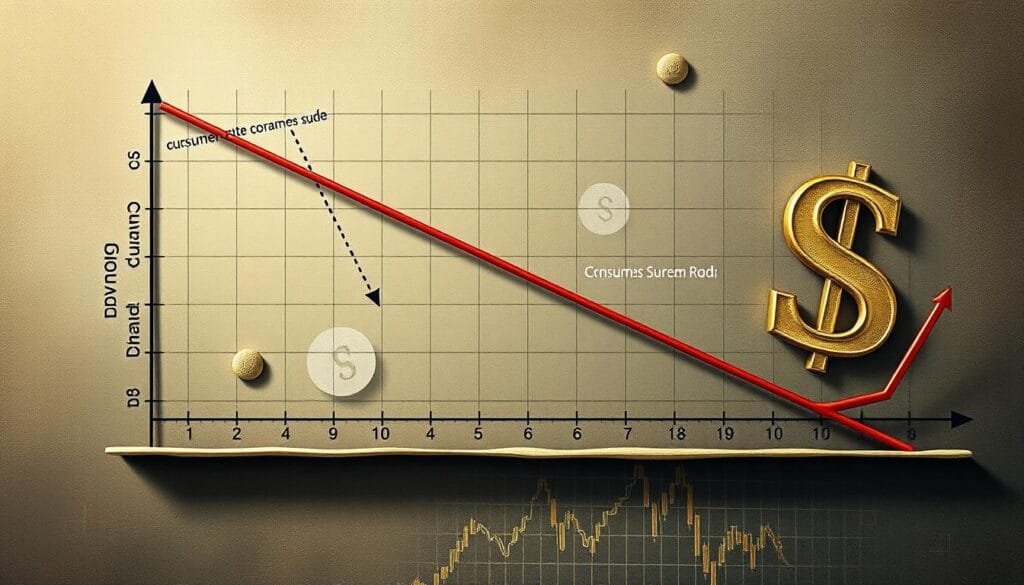How can understanding demand transform your perspective on market movements?
Demand in economics is much more than theory. It’s part of our daily lives, affecting both consumers and businesses. To know how markets work, it’s crucial to grasp demand basics. For consumers, demand shows how willing and able they are to purchase goods and services. This changes with price shifts and how they value things.
For businesses, understanding demand is key. It helps them set prices, manage stock, and maximize profits. Knowing about demand helps predict market trends and consumer buying power. It also guides economic strategies, shaping policies and fostering growth.
Key Takeaways
- Demand reflects consumers’ willingness and ability to purchase goods at various prices.
- The law of demand illustrates an inverse relationship between price and the quantity demanded.
- Diminishing marginal utility shows how we value extra units of a good less over time.
- A demand curve typically slopes downward, showing the law of demand visually.
- Market equilibrium is where supply and demand curves meet.
- Aggregate demand is all the demand in an economy, shaped by fiscal and monetary policies.
What Is Demand?
Demand is key to understanding economics and market operations. It’s about how much of a product or service people want to buy at various prices. The law of demand plays a big part in this. It shows that lower prices make people want to buy more, forming a demand curve that slopes down.
Definition and Concept
The idea of economic demand is seen in individual and market perspectives. Market demand combines everyone’s buying choices in a market. It helps businesses set prices and figure out the market size. Knowing this lets companies meet customer needs better and manage their stock well.
Market Demand vs. Aggregate Demand
Market demand is about the want for specific goods, while aggregate demand is all goods and services wanted in an economy. Aggregate demand shows the overall economic health. For example, central banks keep an eye on it to guide their policy choices.
High aggregate demand can lead to higher interest rates to control inflation. But, in tough economic times, lower rates can boost spending and demand.
The Law of Demand
The law of demand explains how the price of an item and the amount people want to buy relate inversely. It shows us how changes in price affect what people decide to buy. This understanding is key to grasping how the flexibility of price and buying patterns connect.
Inverse Relationship with Price
The law of demand says if an item’s price goes up, people want less of it. We see this on a demand curve, which slopes down showing price against quantity. For instance, when a cupcake’s price jumps from $2 to $4, buyers might reduce their purchase from 5 cupcakes to just 2. This shows how price increases directly affect buying decisions.
The demand curve’s shape can change, appearing concave or straight, depending on the economic situation. Yet, some items like Giffen goods or Veblen goods break this rule. Giffen goods have a demand curve that goes up as the price increases because people buy more. Veblen goods, often luxury items, become more desirable as they get pricier, indicating their status symbol.
Impact of Diminishing Marginal Utility
Diminishing marginal utility is key in understanding the law of demand. It means each additional item you consume brings less happiness than the one before. For example, your first cupcake might taste amazing, but the fifth won’t seem as special. This decline in satisfaction influences how much people are willing to pay, especially as prices climb.
This drop in satisfaction with additional items makes people less inclined to pay high prices, reducing the demand as prices stay high. These insights guide governments and businesses worldwide to adjust policies and strategies, affecting everything from pricing, production, to marketing. Governing bodies use this knowledge to shape economic policies, aiming to balance or boost the economy.
In essence, understanding the law of demand is crucial. It’s a fundamental concept in economics and a powerful tool for analyzing market trends. Both policymakers and businesses can greatly benefit from its insights.
| Factor | Impact on Demand |
|---|---|
| Price Increase | Decrease in quantity demanded |
| Price Decrease | Increase in quantity demanded |
| Consumer Income | Higher income may increase demand |
| Prices of Substitute Goods | Increase in price of substitutes may increase demand for the primary good |
| Consumer Preferences | Change in tastes can shift demand curve |
Determinants of Demand
It’s important to know what affects demand in the market. Many factors play into how consumers act and the economy moves. Price changes and shifts in what people expect can really change how much of a product is wanted.
Price of the Product
How much something costs affects how much people want it. If the price goes up, people usually want less of it. This idea is shown by the demand curve, which shows price and demand moving in opposite directions. For example, when gas hit $4 a gallon in 2008, fewer people wanted big trucks and SUVs.

Consumer Income
How much money people have also changes demand. More money means people can buy more. Less money means they buy less. This was clear when the economy was bad, and folks had less money. Even though house prices went down, fewer houses were sold.
Prices of Substitute Goods
The cost of other similar goods can affect what people buy. If tea gets more expensive, people might buy more coffee instead. If the price of a substitute goes down, then the demand for the related product might drop. A 1% price rise in tea could make more people choose coffee instead.
Consumer Preferences
When people start liking one thing more than another, demand changes. If more people want Windows computers over Apple, that shifts the demand. As tastes change, the demand for certain products moves too.
Future Expectations
What people think will happen later can affect what they buy now. If they expect to make more money or prices to go up, they might buy more today. If they think prices or their income will drop, they might buy less. The housing bubble in the early 2000s showed how expecting higher incomes and house values increased demand, often with risky loans.
For a deep look at what drives demand, including insights into how the market and buying power work, check out this article on the determinants of demand.
| Determining Factor | Impact on Demand | Example |
|---|---|---|
| Price of Product | Inverse relationship; as price increases, demand decreases | Gas prices at $4/gallon in 2008 reduced SUV demand |
| Consumer Income | Direct relationship; higher income increases demand | Economic downturns reducing housing sales |
| Substitute Goods | Price increase in one leads to demand increase for the other | Tea prices rise, coffee demand increases |
| Consumer Preferences | Shifts in preferences increase demand for preferred goods | Demand shift towards Windows computers |
| Future Expectations | Expected higher incomes or prices raise current demand | Housing market demand in early 2000s |
What Is Demand in Economics?
Understanding demand is key for businesses wanting to improve their game. By knowing demand, they can adjust their pricing and make more profit. This helps companies get better at making money through understanding demand.
Significance for Businesses
Demand affects businesses in many ways. By studying it, companies can match what they make with what people want. This reduces waste and increases efficiency.
Also, knowing about demand lets businesses predict the future. They can then change their plans ahead of time. For instance, a company might make more air conditioners before summer when demand goes up.

Determining Prices and Profits
One big reason to understand demand is to set the right prices. By understanding how demand changes with price, companies can charge the right amount. For example, if demand changes a lot with price, companies need to think carefully about price changes.
In the end, knowing about demand helps businesses make more money. They can charge prices that people are willing to pay and control costs. For instance, charging more for car wax can make people think it’s better quality, which can boost sales.
So, understanding demand and setting the right prices can greatly increase profits.
Demand Curve
The demand curve shows the link between a product’s price and how much people want to buy. It mostly slopes downward, showing that higher prices lead to lower demand. This key idea helps us understand how customers act and market trends.

It’s vital to grasp the demand curve in economics. We plot price on the Y-axis and quantity on the X-axis. For example, a drop in price from $6 to $4 might boost sales from 2000 to 3000 units. A price rise, however, can lower sales, showing how demand can stretch or shrink.
If the price of corn goes up by 50% and sales halve, the elasticity is 1. If sales only fall by 10%, elasticity is 0.2. This measure helps us understand how sensitive demand is to price changes.
Everyone’s buying habits are different. Say pizza goes from $1.50 to $1. One person might eat 2 more slices a day. A market-wide demand curve is flatter, meaning prices and sales are more balanced across many buyers. Some items, like Giffen and Veblen goods, even get more popular as they get pricier.
Many things can move the demand curve. Trends, income shifts, and changes in substitute prices can push it up or down. A growing population increases demand, while a declining one decreases it. Factors like income, the price of other goods, and consumer predictions can also cause shifts. Understanding these changes helps businesses and economists foresee how price changes affect buying behavior.
| Price Change | Quantity Change | Elasticity |
|---|---|---|
| 50% Price Rise | 50% Drop | 1 |
| 50% Price Rise | 10% Drop | 0.2 |
| Price of Pizza: $1.50 to $1 | 4 to 6 Slices Daily | N/A |
The shape and slope of the demand curve can be influenced by multiple factors. Adding these details into economic tools gives a full view of the market and consumer patterns.
Market Equilibrium and Demand
Understanding how market equilibrium and demand interact is crucial. We see how balance is found and kept through changes in demand.
Point of Intersection
Market equilibrium is when supply meets demand. In our market equilibrium analysis for gasoline, the perfect price is $1.40 per gallon. Both supply and demand hit 600 million gallons at this point.
| Price per Gallon ($) | Quantity Demanded (millions of gallons) | Quantity Supplied (millions of gallons) |
|---|---|---|
| 1.00 | 800 | 500 |
| 1.20 | 700 | 550 |
| 1.40 | 600 | 600 |
| 1.60 | 550 | 640 |
| 1.80 | 500 | 680 |
| 2.00 | 460 | 700 |
| 2.20 | 420 | 720 |
Shifts in Demand Curve
Several factors can move the demand curve, not just price changes. Shifts can happen with changes in incomes, tastes, or substitute goods prices. For example, a rise in consumer income could push the demand curve right. This means more goods are wanted at every price, affecting equilibrium.
Real-life Applications
Being skilled in market equilibrium analysis and recognizing demand curve shifts is vital for businesses and policymakers. These evaluations help in making key choices. They influence pricing, forecasting trends, and maintaining enough products.
This analysis is essential not just for small decisions but also affects the entire economy. It guides national economic plans and policies. Knowing these concepts helps us handle the complexities of the economy well.
Conclusion
As we wrap up our journey into economics, we see how vital demand is. It’s key for both buyers and sellers. By looking at demand, we understand how prices are set and how they affect buying and selling. Demand helps everyone grasp the complexities of the market.
Demand links directly to what people are willing and able to buy. It influences market balance, where supply meets demand. This balance helps in setting fair prices. Knowing about market forces helps companies plan production and pricing. This leads to growth and happy customers.
In addition, demand plays a big role in making economic policies. Well-informed policies lead to growth and control inflation. Understanding shifts in what people can buy and the influence of other goods is crucial. Mastering economic principles lets us navigate and succeed in the changing economy.
FAQ
What is the basic concept of demand in economics?
In economics, demand shows how much people want to buy goods and services at different prices. It helps us understand market behavior. It also shows how much value buyers place on items and what they’re willing to pay.
What differentiates market demand from aggregate demand?
Market demand is about how much of a product people want in a certain market. It looks at individual choices and buying power. Meanwhile, aggregate demand is the total demand for all goods and services in an economy. It shows the overall economic activity and consumer mood.
How does the law of demand explain the relationship between price and quantity demanded?
The law of demand tells us that price and demand go opposite ways. Usually, if prices go up, people want less. This idea is shown with a demand curve going down.
What role does diminishing marginal utility play in demand?
Diminishing marginal utility means people enjoy extra units of a product less as they have more. This makes them less willing to pay high prices for more, which affects demand.
What factors influence demand for a product?
Demand can change with the product’s price, changes in how much money consumers have, prices of other goods, changing tastes, and what people think will happen in the future regarding prices or availability.
Why is understanding demand crucial for businesses?
Knowing about demand helps businesses decide prices, manage stock, and improve profits. It guides them in planning production to meet what customers want and can afford.
How is the demand curve used in economic analysis?
The demand curve shows price versus demanded amount on a graph. It generally goes down, showing lower prices make people want more. Analysts and companies use it to guess how customers might react to price changes.
What is the significance of market equilibrium?
Market equilibrium is when demand equals supply, shown where the demand and supply curves cross. Understanding demand shifts helps analyze market trends. It’s key for planning in business and policy-making.
What are some real-life applications of demand analysis?
Demand analysis is used for setting prices, predicting market moves, planning production, and forming policies. It helps respond to market changes and consumer behaviors effectively.
